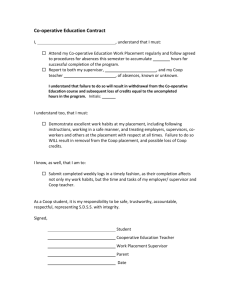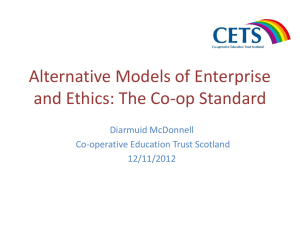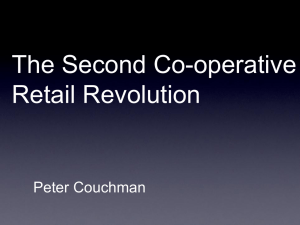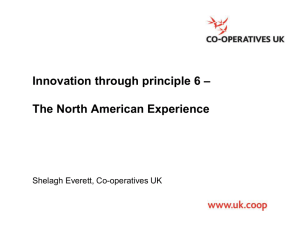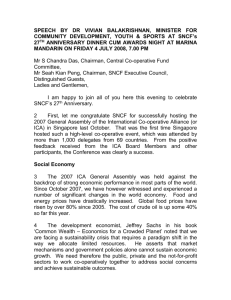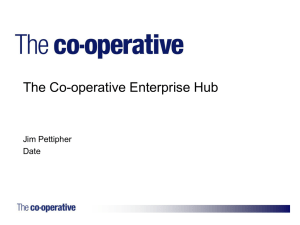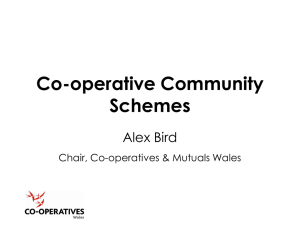Dia 1 - Co-operatives UK
advertisement
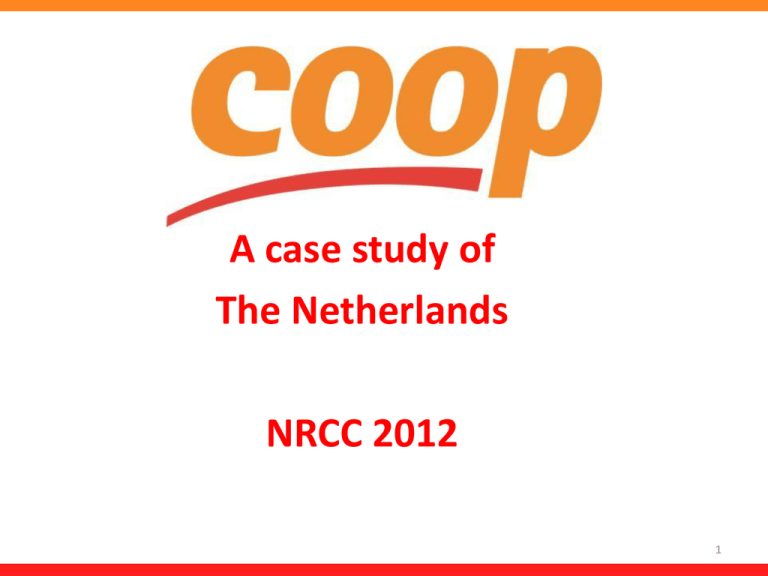
A case study of The Netherlands NRCC 2012 1 2 3 4 Strategies for increasing market share 5 History goes back to 1891 6 A tour through history Around 1970 Coop Netherlands, a national organisation of Dutch co-operatives (market share 7.5%) with: • mainly small sized supermarkets, • distribution centers, • a few restaurants and hotels, • bakeries and some other food production facilities and furniture and textile shops. 7 A tour through history Co-operative downturn 1970-1975 • Dutch co-operatives failed to concentrate and to cooperate, national co-operation was frustrated out of perceived own interest of individual co-operatives: umbrella organisation Coop Netherlands was dissolved • Mismanagement: If concentrated, management was unable to respond to the needs caused by the increased complexity and growth • Failure to timely adapt to rapid changes in competition and economic circumstances 8 A tour through history Co-operative downturn 1975-1990 • Most Dutch co-operatives were sold to commercial enterprises, were dissolved or went bankrupt • The only 2 surviving regional co-operatives merged into the present Coop organisation • Disposal of all other business segments than supermarkets BUT • Again, mismanagement in late eighties, due to an internal focus rather than an consumer based orientation 9 Rather tough times 10 Market share dropped and so did the results 11 Coop needed reconstruction 12 Back on track Co-operative turnaround Around 1990 Around 1990 Coop’s market share only was 0.75% • Hiring of a turn`around manager and board professionalisation • External focus: extensive shop redesigning and equal marketing/advertising activities (Coop Club Card) • Switch from joint purchasing group • Significantly increased level of cost consciousness resulted in an efficiency and reorganization program • Acquisition of bigger locations was key 13 Strategy map - 4 supporting pillars Slogan: At Coop, you’re the boss Mission: ‘Coop is a service oriented, clearly positioned, independent co-operative that, whilst it is fully conscious of its position in society, deliveres an optimal variety of food and related products/services to its consumer and franchise members. Core values: Co-operation, Entrepreneurial, Trustworthy, 1 Coop distinctive power 2 Using economies of scale 3 Sound growth 4 Excellent operations A. Growth initiatives: Project development & store /chain acquisitions B. Find growth opportunities in existing locations 14 Continuous and ongoing fight for position on service and price level, a lot of players ‘in the middle’ Cheap Discount / Price Low service High service Service Middle Expensive 15 Continuous battle in the playing field 16 Fragmented landscape, market leader 34% market share, hard discounters 14% market share and show steady growth Stores # Average size m2 33.6% 850 1,261 ₤ 9,406 Service 12.0% 406 986 ₤ 3,360 Value for money 10.0% 222 1,124 ₤ 2,800 Quality discount 6.0% 263 920 ₤ 1,680 Service 4.2% 99 1,041 ₤ 1,176 Quality discount 2.5% 125 1,025 ₤ 722 Value for money 2.7% 207 680 ₤ 757 Service and value for money 1.4% 285 305 ₤ 392 Service 2.1% 61 1,027 ₤ 588 Value for money 1.6% 56 1,113 ₤ 448 Value for money 1.0% 55 1,039 ₤ 280 Value for money 0.7% 34 959 ₤ 210 Quality discount 1.0% 29 1,064 ₤ 280 Quality discount Market share Gross Sales (in ₤ mln) Buying Market segment 17 Price is a hot issue in the Netherlands Source: Eurostat 18 Case studies • Merger Coop and Codis, 2001 • Acquisition of: 11 stores of DeWitKom@rt, 2005 18 EDAH stores, 2006 24 SuperdeBoer stores, 2010 19 5 D’s Dream Discipline Differ Do Dare 20 What’s your dream? 21 Opportunity 22 Do it! 23 Edge upwards Co-operative growth 1995 - 2011 Merger Coop • Consumer co-operative with own Coop shops: • Outsourced logistics • Member of a purchasing co-operative, Superunie • Mid Netherlands Codis • Franchise based co-operative, outdated formats/concepts • In house warehousing/logistics • Member of a privately owned purchasing company • North East and South West Netherlands 24 Dare 25 International business opportunity? Consumer Co-operatives Forum 2012 AND BEYOND: BUSINESS STRATEGY OF CONSUMER CO-OPERATIVES London, 29th & 30th September 2011 26 Competion Authorities 27 Edah acquisition case 28 If necessary, create a consortium 29 Monster multi member consortium 30 Discipline is essential 31 Store allocation, bidding, financial backing 32 Road show for franchisees turned out to be a brilliant idea 33 Mergers of consumer co-operatives 6 recommendations 1. Separate commercial from governance integration in implementation stage 2. Make a plan to achieve rapid commercial integration 3. Early establish clearness about leadership of merged society 4. Ensure transparency in decision making process 5. Get all stakeholders’ support 6. Provide stakeholders opportunity to help shape governance of new co-operative society 34 Acquisitions made by co-operatives 6 recommendations 1. Evaluate financial resources 2. Make a good commercial integration plan 3. Raise new employees’ awareness on co-operative principles and values 4. Make sure employees understand growth through acquisition is beneficial 5. Secure members’ particular advantages 6. Stress co-operative differences in the retail market 35 Immediately deal with leadership issue 36 Execute as military operations 37 Buddies are here to help 38 Stress the co-operative difference 39 Wrap up 40

